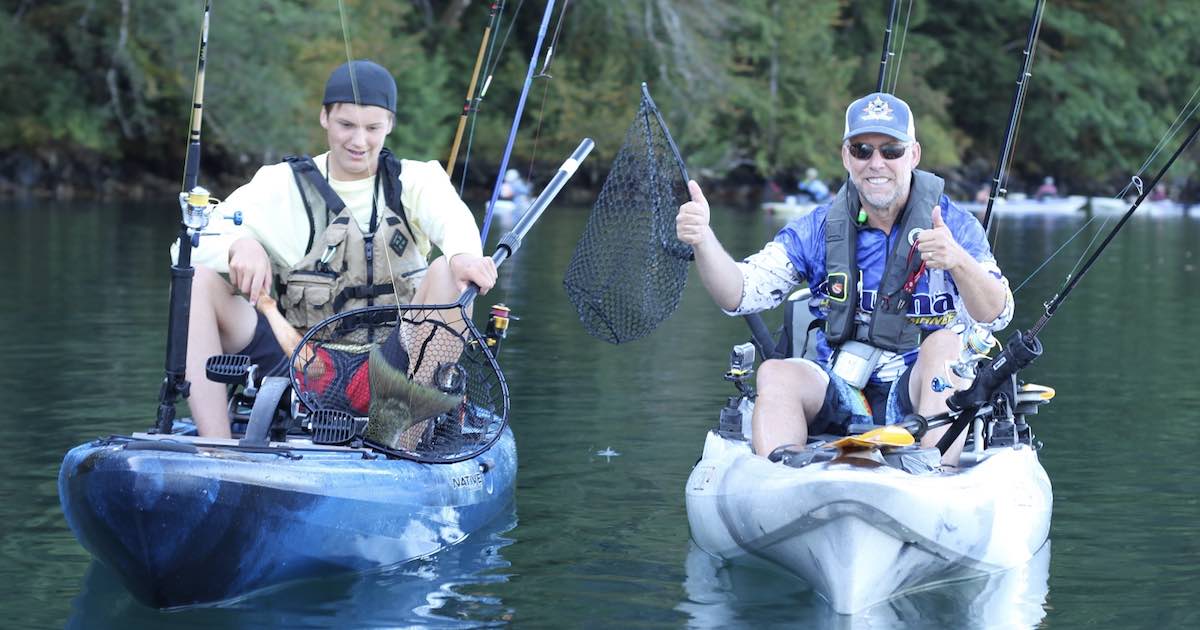
In my last article, I outlined all the reasons why kayak fishing is a great alternative to more traditional ways of getting on the water and catching fish. In this installment, I’ll try to simplify the process of buying a fishing kayak in a world where there are simply too many options. You can search the internet and find a plethora of articles, videos, and reviews on the types and brands of kayaks. These are all great resources, but where to begin?

Kayak fishing
The first step is to determine exactly what you’ll use the kayak for. It’s important to know where you most like to fish now and where you are looking to try fishing in the future. Are you are looking to travel long distances or strictly stay near shore? Do you plan to use your kayak only in the saltwater, only in freshwater, or both? These are key factors in terms of kayak type (paddle, pedal, motor drive option, or combination), kayak design/shape, and the construction/durability. For those looking to primarily paddle and prefer to access the saltwater, a lower profile, lighter weight, and streamlined design make for a more enjoyable day and handling in all conditions. If you prefer lakes, need to access different types of water, and want to fly fish, then the heavier, rotomolded tri-hull pedal drives are the best boat for you. And for those who want to do it all, there are boats optimized for this as well. Once you’ve determined your planned usage, it’s time to dig into greater detail.
CONSTRUCTION AND DURABILITY
The more you plan to use your kayak, the more durable it needs to be (and the more it will likely cost). Construction type and materials make a difference. For fishing kayaks, we generally classify three types:
Poly (Polyethylene or Multi-Layer Plastic)

Polyethylene kayak
These are generally the low-end price point and represent those found in your big box stores like Canadian Tire. Great starter kayaks to introduce yourself to the sport but have limitations in long-term durability and stability.
Thermoformed
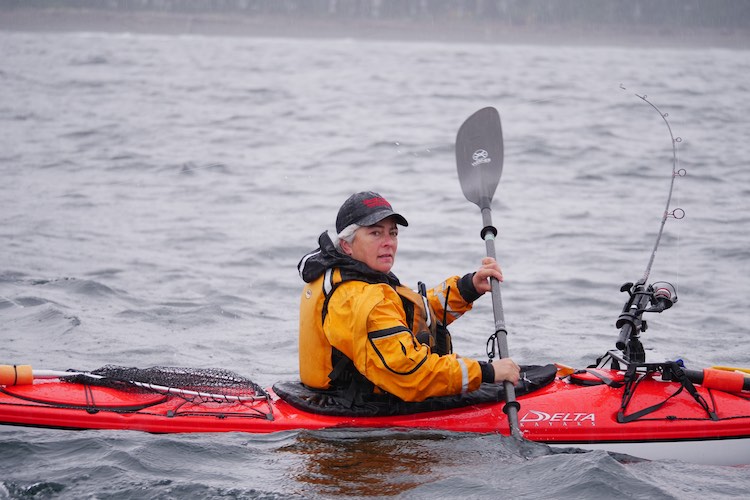
Thermoformed kayak
These generally feature two-piece construction of oven-molded ABS with dynamic surface layers (i.e. acrylic infused) to protect and harden the shell. In this method, the top and base are formed over the mold instead of in the mold. For those that are used to ocean kayaking, these represent your closest crossover and have the similar glossy finish but are much more durable than composites (fiberglass, kevlar). The most expensive of the three types, thermoformed kayaks are lightweight, track extremely well, and are ideal for paddling (none are made with pedal drives yet). Two great examples of these boats are Delta Kayaks and Eddyline Kayaks.
Rotomolded
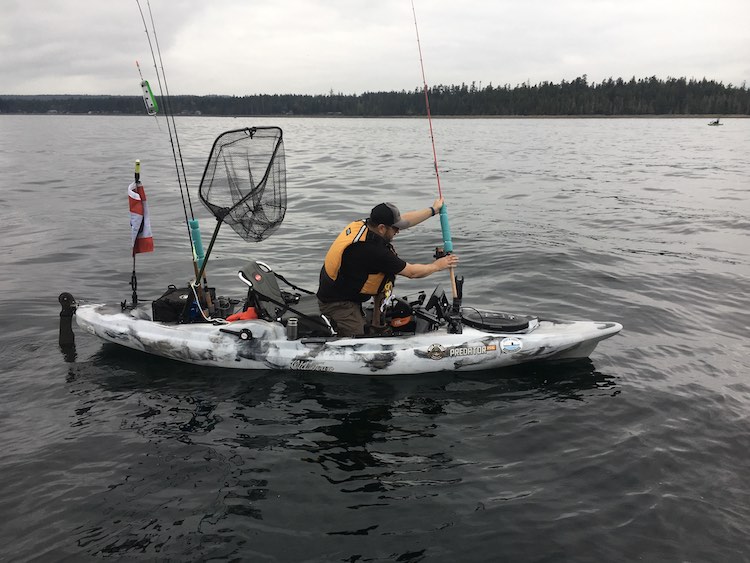
Rotomolded kayak
These have become the staple of kayak fishermen. Materials used in the construction are similar to poly, but the process is different. The use of complex molds and variable temperature ovens allows the materials to be shaped in thicknesses that are varied according to strict engineering tolerances. These are the heaviest of the group, but are extremely durable and constructed to outfit for fishing. Drop it, haul it up on barnacles, drag it across the sand— there’s not a lot to worry about here. With some proper care and maintenance, these boats will last a lifetime. That said, once you get hooked, you will probably upgrade every few years.
PROPULSION
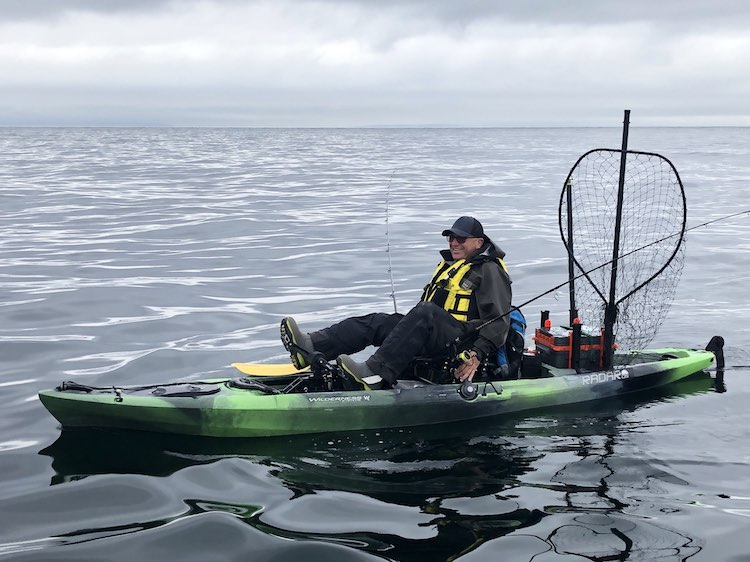
Pedal drive kayak
Pedal drives are the latest kayak fishing trend, and they offer great performance and hands free operation (so you can focus on the fishing). For those considering trolling, battling tides and currents to stay on the bait or a given structure, or looking to cover a lot of water in a day, pedal drives are the way to go. Believe it or not, most of these will propel the kayak up to 8 km/h with a fairly easy pedal. That’s not quite the 8 knots needed for tuna, but plenty of speed for our salmon fishery! The downside of pedal power can be cost, as the pedal drive units themselves are often equivalent to the price of the kayak. Look for drives that offer good warranties and are fully or mostly sealed units, and you won’t be disappointed in the investment.
Paddling, on the other hand, is still my go to for a relaxing day on the water. Although trolling can be more limited or challenging, most other methods of fishing can be easily accomplished with some practice. One of the biggest upsides of paddling is the increased deck space for gear or fish. As with most things, “try before you buy” is a great option. There are many pure paddlers fishing our waters and many that find pedal power is the way to go. Do some homework and choose what is right for you.
INSIDE OR OUTSIDE
Traditional kayaks put your legs below deck and are paddle only. With the addition of a spray skirt, this offers additional warmth, dryness, and protection from the weather. These kayaks are generally less stable than a sit-on-top and more difficult to get in and out of. Once on the water, however, mobility and responsiveness of the kayak is better. The movement to the sit-on-top models offers its own benefits. Launching and disembarking is much easier, particularly into the surf, while the added weight increases natural buoyancy and stability on the water. Access to gear is another advantage, as everything is topside and within reach. A final consideration here is that righting and re-boarding a sit-on- top is much easier.
LEVEL OF KAYAKING EXPERIENCE
I like to know this detail, as it helps direct people to the most successful option. For people with no experience, stability will be of high importance. If you’re fighting to remain upright or feel balanced in the kayak, you probably won’t enjoy it. This generally means finding a kayak with greater width (beam), heavier weight, and a tri-hull type design. For experienced paddlers who are comfortable with ocean kayaking and looking for something new to try, investigate the thermoformed or rotomolded options like the Ocean Kayak Trident Series. This will provide a similar feel while optimizing your fishing experience. And finally, for those with moderate experience, the choice is endless. I would focus on your planned use and durability requirements before making your final purchase.
TRANSPORTATION
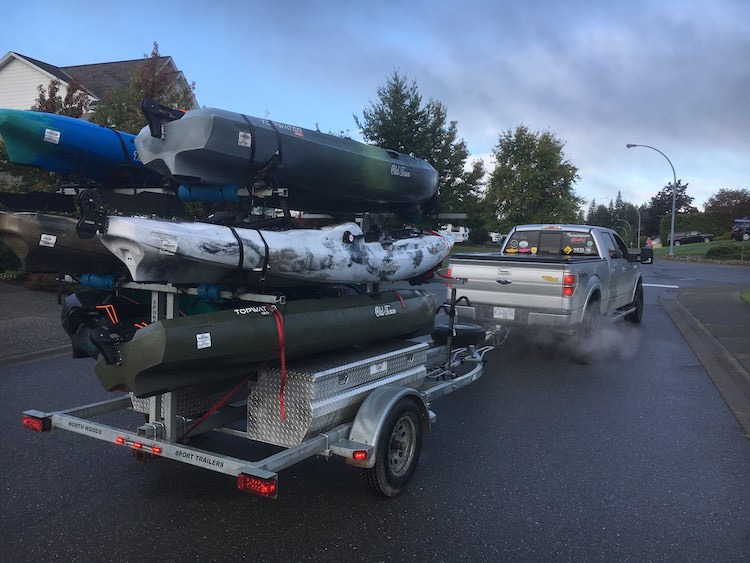
Transporting kayaks – large trailer
This is the aspect overlooked by most first-time buyers. How are you going
to get your kayak to the launch site? Will you be by yourself or with others, and how remote are you looking to go? Secondly, do you have a truck/trailer or are you loading onto your car? There are a variety of options available through manufacturers such as Malone Auto Racks, Thule, and Yakima for roof and/ or trailer mount kits and loaders. With the diversity in kayak weights and hull design, make sure you have the right equipment for the job. Many people have this part covered but forget what’s required once the kayak is unloaded from the vehicle. We often have trails or small ramps to get down in order to launch. A kayak cart is a worthwhile investment, and I recommend spending more to get more versatile models. It’s money well spent, and you won’t be disappointed.

Malone kayak cart
SHOP LOCAL
There are many brands, makes, and models of equipment to choose from, but many of these are not readily accessible in Canada. It’s also important to choose brands that are sustainable and have been around for some time. With growth in the sport, many new manufacturers have appeared in recent years, and I believe that many will disappear as well. Look for a local brand that’s been around a while. In the Pacific Northwest, key brands are Old Town Canoe & Kayaks, Ocean Kayaks, Wilderness Systems, and Riot Kayaks. All can be found on the island and provide a variety of options for novice and experienced paddlers and fishermen.
If you want to give the sport a try, look to a few of the existing rental providers on the island—hopefully there are more to come. Alternately, find a kayak fisherman you know to take you out, look for a used model on the internet, or purchase the least expensive model that meets your needs identified in this article.
If you have questions on any of the material in the article, feel free to email me at westcoastyakseries@gmail.com.
Be safe on the water, and take someone fishing.
One Comment
Leave A Comment
Visit the Store
$34.99
$34.99
Featured Catch

Joel Unickow halibut (Photo: Rob Frawley Lucky Strike Sportfishing Tofino)








What type of boat would you recommend for saltwater areas with very strong tides? I fish mostly around Lasqueti Island and currently use an Aquaglide Inflatable (not rockfish friendly!).
I’m wanting to keep things light and simple as water access is very challenging near us. Wilderness System Tarpon 120 or 140 are currently at the top of the list.
Any thoughts on either of those?
Cheers.